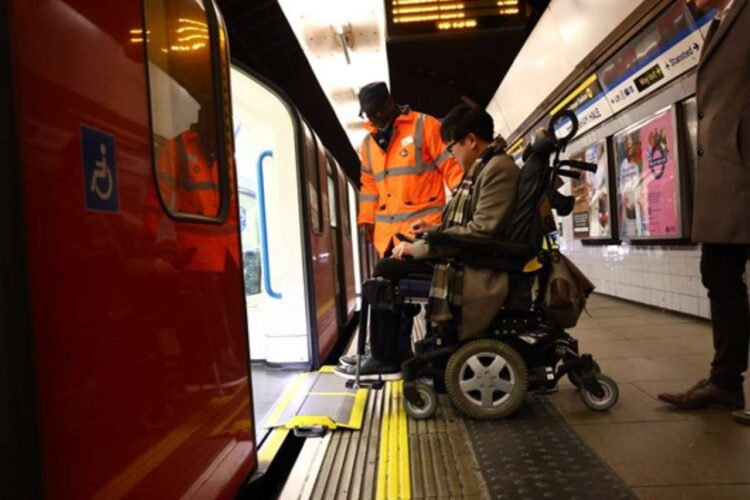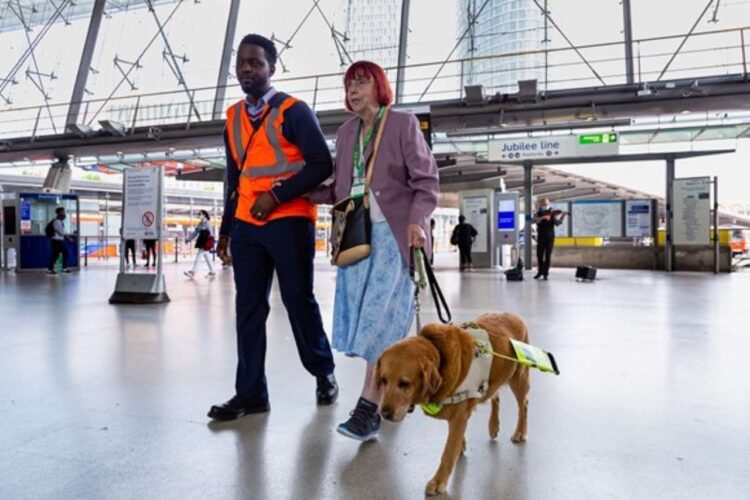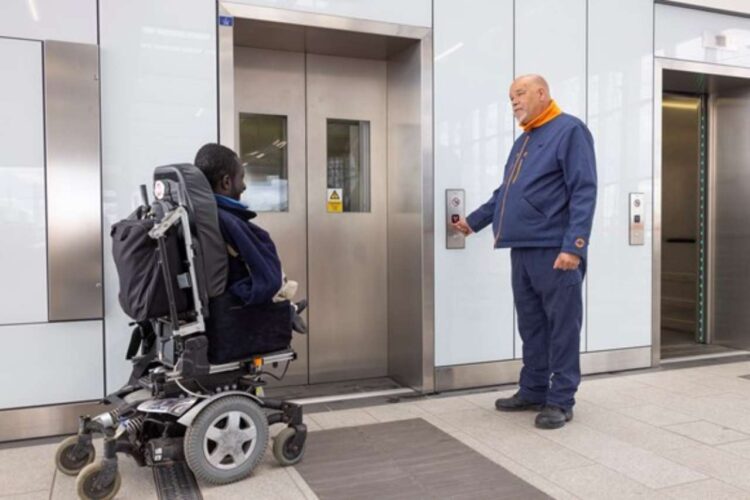Transport for London (TfL) has published a new plan, Equity in Motion, which it says aims “to help create a fairer, more accessible and inclusive transport network for everyone”.
The plan, which is available to read here on the TfL website, commits to more than eighty measures to progress TfL and the Mayor of London’s ongoing efforts to create a fairer and safer London.
The commitments cover key areas around accessible travel, keeping passengers safe, understanding people’s needs, affordable travel, inclusive information, and connecting Londoners.
One measure will be the introduction of a bridging device for use at stations which are designated step-free from street to train but have a gap between train and platform.
Following a trial on the Jubilee line two years ago, more than forty-five of these mini-ramps are being introduced across the network. They are designed to provide additional support and reassurance for passengers, after TfL research showed that 63 per cent of respondents would be more likely to travel with this device.

TfL will carry out new research to understand the needs of London’s different communities and will create a new inclusive Design Centre of Excellence. It also plans to:
- review its approach to translating communications into different languages, including British Sign Language
- increase the number of stations with step-free access
- expand the Project Guardian school sessions on sexual harassment
- make it easier for people to report crime, antisocial behaviour, discrimination, and safety concerns.
TfL reports that it is already carrying out some of these improvements, and the they will help to make everyone feel welcome on the transport network and enable more people to travel with confidence and ease.
Millions of Londoners face barriers to using public transport. Nearly a third of London’s population lives in poverty, and around one in six are disabled. Poor street environments, low air quality and road danger have an adverse impact on all Londoners, but disproportionately affect marginalised groups.
TfL describes its new commitments as “bold”, points out that they include both short- and long-term measures, and states that they focus on “creating an equitable customer experience, protecting, and enhancing connectivity, keeping travel affordable and reducing health inequalities.”
They are among a number of actions that the Mayor of London is taking to progress his Transport Strategy, which aims to “move London forward safely, inclusively and sustainably”. Several measures are due to be delivered this year, and others will be implemented by 2030 if the government provides funding.

The plan’s commitments include:
Accessible Travel
- increasing the proportion of step-free Tube stations to one-half: only one-third of Tube stations has step-free access, although this has increased from one-quarter since Sadiq Khan became Mayor;
- mini-ramps to cover the gap between the train and platform at all London Underground platforms that are step-free to train;
- an innovation challenge aimed at improving travel for disabled people;
- more dedicated spaces for wheelchair users and buggies on Bakerloo, Central and Waterloo & City line trains;
- a feasibility study into how TfL can increase toilet provision for passengers;
- priority seating moquettes installed on one thousand Routemaster buses by 2025;
- deliver a new equality impact assessment (EqIA) awareness programme and supporting TfL staff with training.
Keeping Passengers Safe
- expanding TfL’s Project Guardian school sessions on sexual harassment to twenty-eight thousand Year 9 students;
- making it easier for passengers to report crime, antisocial behaviour and safety concerns; including reporting to TfL’s website and TfL Go app by 2026;
- training staff to help reduce all forms of harassment and support victims;
- safety audits to gather data which will enable TfL to design public spaces to improve the safety of all its passengers, including women, girls and gender-diverse people
- a series of innovation challenges considering how to reduce discrimination and improve safety on buses and escalators;
- continuing to engage with communities on streetscape design schemes, including infrastructure such as bus stop bypasses
Understanding Customers
- creating of a new inclusive Design Centre of Excellence;
- researching the needs of a range of communities in London, including LGBTQ+ people;
- reviewing TfL’s approach to engaging with its passengers and stakeholders to ensure that it hears a diverse range of voices;
- disability equality training for frontline staff.
More Affordable Travel
- a new travel concession entitling eligible care leavers to half‑price bus and tram travel;
- a study of how cost of travel affects people with protected characteristics, which TfL will use to guide its decisions on its investment priorities.
Inclusive Information
- self-service for Dial-a-Ride, enabling users to book, amend and cancel trips;
- reviewing TfL’s approach to translating communications into different languages, including British Sign Language;
- adding virtual tools to the TfL Go app and website to help passengers better understand how to access the transport network;
- hundreds of new real-time information displays at bus stops and shelters;
- reviewing wayfinding at interchanges to ensure directions meet diverse needs.
Connecting Londoners
- inclusivity audits at stations, and near developments;
- research into barriers to walking across protected characteristic groups;
- expanding electric cycle hire, particularly in areas of high deprivation.
TfL has started work on many of the plan’s longer-term actions, including improving safety standards for heavy goods vehicles, introducing new cycle lanes, and reducing road danger.

Mayor of London, Sadiq Khan, said: “London is for everyone and I am committed to making our transport network as fair and accessible as possible so that every Londoner can make the most of our fantastic city.
“TfL is committed to removing the barriers that people face when using the transport network and enabling more people to travel spontaneously, seamlessly and easily. Some of these vital improvements are already underway and there are many more to come, helping us to continue building a better, fairer London for everyone.”
Alex Williams, Chief Customer and Strategy Officer at TfL, said: “Our vision is a London where everyone can move around the city safely, inclusively and sustainably, and access to public transport is a fundamental component in making this happen. While we have taken steps to make our network more accessible, we know that much more needs to be done. Equity in Motion draws on the experiences and viewpoints of a range of Londoners, prioritising the areas they want to see improved to create tangible actions that drive forward change and help make London a truly fair city.”
Agnes Fletcher, Member of TfL’s Independent Disability Advisory Group, said: “We were pleased to have the opportunity to contribute to the development of the Equity in Motion plan for London.
“All Londoners will benefit from the change it promises, including more affordable travel and cleaner air. And more people with impairments, with long-term health conditions and who are neurodivergent will be able to use the transport network, and to reach more of London safely and comfortably.
“Disabled people are part of every demographic and every community. The barriers we face just in getting around – to work, to access healthcare, to see family and friends, to access all the wonderful things London has to offer – can be reduced or removed by taking enabling actions like those in Equity in Motion. The result will be a cleaner, greener, more active and enjoyable London – where everyone feels as though they matter.”
Emma Vogelmann, Policy and Public Affairs Manager at Transport for All, said: “These new commitments are really encouraging for the 1.2 million Londoners who are disabled, and are a positive approach to addressing some of the most significant barriers we face when getting around the capital.
“Access barriers for travelling in London include a lack of step-free stations, few priority seats on buses, and missing or inaccessible travel information – all of which can conspire to making our journeys longer or more painful, or even stop us getting beyond the front door. We’re pleased to see TfL commit to making changes to tackle these barriers. Coproducing schemes with the disabled community will be vital to ensure the measures in this plan can bring about real change.”






Responses